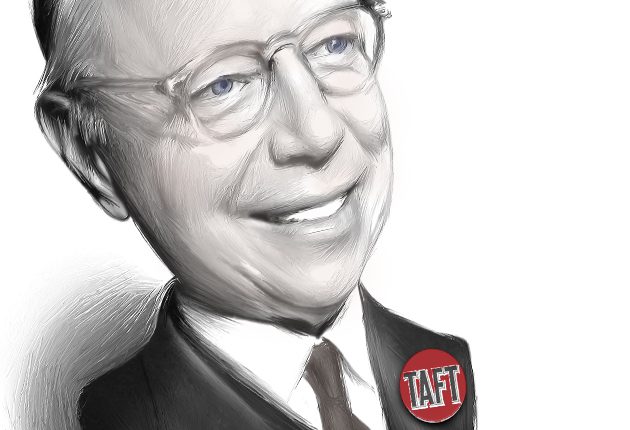A Missing History of Conservatism

I confess: when I received my review copy of Garland Tucker’s Conservative Heroes, all I could think was, been there, done that. Having endured my share of collections that outwardly resemble Tucker’s book, I am drearily familiar with the genre: commonplace, conventional, and generally inoffensive historical figures, of the sort all right-thinking people are expected to admire, are solemnly commended to the reader as model conservatives.
That’s why Tucker’s book came as such a pleasant surprise: here are plenty of figures—from Nathaniel Macon and John Randolph of Roanoke to John C. Calhoun and Robert Taft—who play rather a minor role, or are actually cast as villains, in the neoconservative version of American history.
Tucker sidesteps a major dispute in intellectual history by frankly treating American conservatism as synonymous with classical liberalism. Thus the political philosophy whose fortunes are chronicled in Conservative Heroes “was originally called ‘classical liberalism’ but now more often is termed ‘conservatism’.”
The ideas Tucker associates with conservatism are familiar ones: a disbelief in the perfectibility of man, a commitment to limited government, support for private property, and a conviction that private virtue is necessary for the maintenance of a free and just society. But as I say, the people he chooses to illustrate these principles are far less familiar, and that’s a good thing.
Tucker’s is an adequate if not inspired overview of Southern statesman and political theorist John C. Calhoun—I’m partial to the brief biography of Calhoun I find in Forgotten Conservatives in American History, a similar volume released several years ago by Clyde Wilson and Brion McClanahan—but I am impressed all the same to see Calhoun in a mainstream conservative book like Tucker’s in the first place. Modern conservatism with its nationalist idiom cannot understand Calhoun, much less respect the gravity of the problems he identified. And Tucker’s discussion of the South Carolina Exposition and Protest—which, if I may gently correct the author, was two documents, not one—of 1832 gets to the heart of Calhoun’s concerns.
Any society will have its competing and incompatible interests. In the United States, Calhoun found, those competing interests were by and large geographically defined: the North and the South, generally speaking, had opposing views on many of the key issues important to both regions.
“The interest of the two great sections is opposed,” Calhoun wrote. “We want free trade—they restrictions; we want moderate taxes, frugality in Government, economy, accountability, and a rigid application of the public money to the payment of debt, and to the objects authorized by the Constitution. In all these particulars, if we may judge by experience, their views of their interest are precisely the opposite.”
How to prevent the various interests in society from using their electoral strength to oppress one another was the task that consumed Calhoun, and it was at the heart of his idea of the “concurrent majority” and his version of state nullification. Wrote Calhoun: “It requires the greatest wisdom and moderation to extend over any country a system of equal laws; and it is this very diversity of interests, which is found in all associations of men for a common purpose, be they private or public, that constitutes the main difficulty in forming and administering free and just governments.” No delusional happy talk about “democracy” here.
Also making an appearance here is Grover Cleveland, who along with Calvin Coolidge and Ronald Reagan is one of three U.S. presidents to feature in Tucker’s book. Cleveland’s virtues are familiar to students of American history, though few of us ever heard them presented as virtues. Cleveland was anti-inflationist, generally laissez-faire, a constitutionalist, and while not a strict noninterventionist, certainly an opponent of the drive toward imperialism that was gathering steam in the late 19th century.
This latter quality is absent from Tucker’s story of Cleveland, but it, too, was evidence of the president’s conservative temperament. He had no sympathy for the interventionist agitators who wanted a war over Cuba and even said he would refuse to call up the army if Congress should declare such a war. He made no moves to annex Hawaii, frustrating imperialist ambitions yet again, this time on the grounds that annexation was being pursued by parties who had had a hand in foisting an unrepresentative regime on the Hawaiian people.
What we do read about in Tucker’s tale is Cleveland’s approach to domestic affairs, although the president’s handling of labor union violence is likewise curiously absent. But the chapter is certainly filled with illustrative examples of Cleveland’s governing style and policy positions.
For instance, when in 1887 several counties in Texas had suffered a terrible drought and Congress proposed a $10,000 grant for seed grain, Cleveland vetoed the bill. His reasoning was instructive. Cleveland said he could not “indulge a benevolent and charitable sentiment through the appropriation of public funds.” (As it turned out, $150,000 in voluntary charitable donations was raised for the purpose.) Cleveland simply could find “no warrant for such an appropriation in the Constitution.”
Most Americans will not have heard of the majority of the people Tucker discusses in Conservative Heroes, and those figures whose names are familiar are generally known to the public only in caricature. Calvin Coolidge, the 30th president, is a prime example. Every schoolboy has heard Coolidge’s remark that the chief business of the American people is business. He has probably not heard, from the very same 1925 speech:
It is only those who do not understand our people, who believe our national life is entirely absorbed by material motives. We make no concealment of the fact that we want wealth, but there are many other things we want much more. We want peace and honor, and that charity which is so strong an element of all civilization. The chief ideal of the American people is idealism.
Coolidge may be a familiar enough name, but I rather suspect that even most conservatives and libertarians, especially young ones, will be unfamiliar with Josiah W. Bailey or the “Conservative Manifesto” of 1937 he played such a key role in drafting. Bailey belonged to the dwindling but pugnacious Jeffersonian wing of the Democratic Party and sought to foster a coalition of Republicans and conservative Democrats to stop Franklin Roosevelt’s New Deal. Rather an interesting historical moment, but not exactly front and center in the typical classroom discussion.
Bailey had been involved in another bipartisan effort before the Conservative Manifesto: the campaign against FDR’s court-packing scheme. (The president sought to add an additional justice for every existing justice over age 70; this was, he said in all seriousness, to help them with their caseload.) Reflecting on Bailey’s denunciation of the plan on the Senate floor, Senate Majority Leader Joseph Robinson observed, “That rare thing, a successful and convincing argument, was being made on the Senate floor.” In the end, FDR had to abandon the plan.
What became known as the Conservative Manifesto was a statement of principles in opposition to the New Deal, though it did not mention FDR by name. It was a systematic critique of the economic program of the vast bulk of his own party. Just as Bailey was assembling his coalition, though, the document was leaked to the press by Senate Minority Leader Charles McNary, a Republican who thought the manifesto would hurt his party’s election prospects. The resulting confusion left the whole plan in shambles, and it simply withered away.
Senator Robert Taft, still another figure Tucker highlights who frankly offends today’s neoconservatives, likewise receives a favorable hearing. Although Tucker notes in his discussion of the 1940 election that Taft opposed the internationalists in the Republican Party, he makes no mention of his showdown with Dwight Eisenhower for the party’s 1952 presidential nomination, in which Taft’s loss represented the beginning of the end of the party’s less interventionist wing.
Tucker’s story, moreover, would have been more surprising and indeed arresting had he included Taft’s skepticism of the Truman Doctrine, the Marshall Plan, and the creation of NATO. A conservative made arguments against some of the best-known initiatives of the early Cold War, and these don’t make the cut in the Taft chapter? That’s hard to excuse.
As I said, judging only from the title I might have expected this book to profile Alexander Hamilton, Daniel Webster, Abraham Lincoln, Theodore Roosevelt, and other safe and conventional figures to whom mainstream left and right do equal obeisance. But the world can get by just fine without still another forgettable volume in that tradition, and it is very much to his credit that Tucker refused to produce one.
There is, thank goodness, more to conservatism than Bill Kristol and so-called right-wing radio, and if younger conservatives discover this helpful and gently subversive book, they might have a fighting chance of encountering a tradition their elders prefer to leave dead and buried.
Thomas E. Woods Jr. is a senior fellow of the Ludwig von Mises Institute and the author of 12 books, including The Politically Incorrect Guide to American History.
Comments